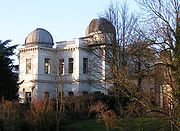
Leiden Observatory
Encyclopedia

Astronomy
Astronomy is a natural science that deals with the study of celestial objects and phenomena that originate outside the atmosphere of Earth...
observatory
Observatory
An observatory is a location used for observing terrestrial or celestial events. Astronomy, climatology/meteorology, geology, oceanography and volcanology are examples of disciplines for which observatories have been constructed...
in the city of Leiden, Netherlands
Netherlands
The Netherlands is a constituent country of the Kingdom of the Netherlands, located mainly in North-West Europe and with several islands in the Caribbean. Mainland Netherlands borders the North Sea to the north and west, Belgium to the south, and Germany to the east, and shares maritime borders...
. It was established by Leiden University
Leiden University
Leiden University , located in the city of Leiden, is the oldest university in the Netherlands. The university was founded in 1575 by William, Prince of Orange, leader of the Dutch Revolt in the Eighty Years' War. The royal Dutch House of Orange-Nassau and Leiden University still have a close...
in 1633, to house the quadrant of Snellius
Snellius
Snellius may refer to:*Rudolph Snellius , a Dutch linguist and mathematician at the Universities of Marburg and Leiden*Snellius , a lunar crater located near the southeast limb of the Moon...
, and is the oldest operating University observatory in the world (before this, astronomy taught at medieval universities tended to be of a more theoretical nature, and any observations were usually done with private equipment rather than at University observatories —see this timeline
Timeline of telescopes, observatories, and observing technology
-3500s BC:*The earliest sundials known from the archaeological record are the obelisks ancient Egyptian astronomy and Babylonian astronomy-1900s BC:*Xiangfen Astronomical Observatory, Xiangfen County, Linfen City, Shanxi Province, China-600s BC:...
).
The original observatory used observing platforms on the roof of the main university building
at the Rapenburg. In 1860 a large, modern observatory was erected at the Witte Singel. This
building was the home of the astronomy department until it moved to the science campus north-west
of the city centre in 1974. Although professional astronomical observations are no longer carried out from Leiden itself, the department still calls itself Leiden Observatory. Today's astronomers instead travel to the big observatories, e.g. ESO
ESO
ESO, as a three-letter abbreviation, may stand for:* European Southern Observatory* Ensemble Studios Online* English Symphony Orchestra* Edmonton Symphony Orchestra* Executive Stock Options...
's VLT
VLT
VLT may stand for:* Very Large Telescope, a system of four large optical telescopes organized in an array formation, located in northern Chile...
in Chile.
The astronomy department (Sterrewacht Leiden) is the largest in the Netherlands and is internationally renowned, performing research in a wide range of astronomical disciplines.
A number of prominent astronomers and physicists have done work at Leiden Observatory, including Willem de Sitter
Willem de Sitter
Willem de Sitter was a Dutch mathematician, physicist and astronomer.-Life and work:Born in Sneek, De Sitter studied mathematics at the University of Groningen and then joined the Groningen astronomical laboratory. He worked at the Cape Observatory in South Africa...
, Ejnar Hertzsprung
Ejnar Hertzsprung
Ejnar Hertzsprung was a Danish chemist and astronomer.Hertzsprung was born in Copenhagen. In the period 1911–1913, together with Henry Norris Russell, he developed the Hertzsprung–Russell diagram....
, and Jan Oort
Jan Oort
Jan Hendrik Oort was a Dutch astronomer. He was a pioneer in the field of radio astronomy. The Oort cloud of comets bears his name....
, all of whom have served as Directors. Another famous employee was Jacobus Kapteyn
Jacobus Kapteyn
Jacobus Cornelius Kapteyn, was a Dutch astronomer, best known for his extensive studies of the Milky Way and as the first discoverer of evidence for galactic rotation....
.


